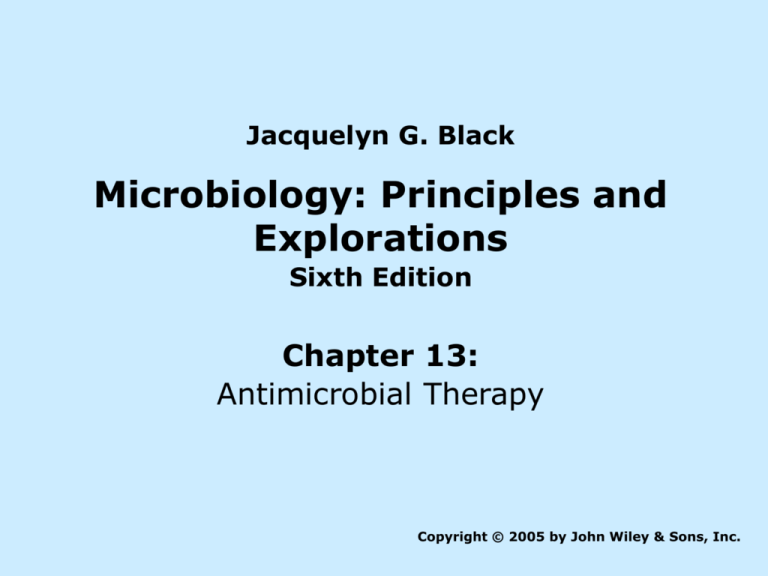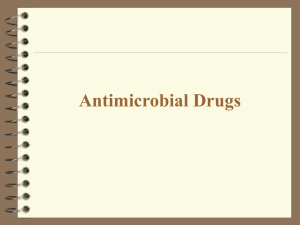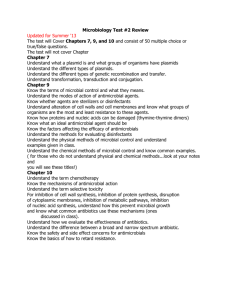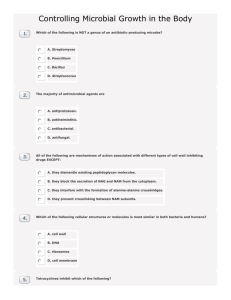Chapter 13
advertisement

Jacquelyn G. Black Microbiology: Principles and Explorations Sixth Edition Chapter 13: Antimicrobial Therapy Copyright © 2005 by John Wiley & Sons, Inc. Antimicrobial Agents • A special group of chemotherapeutic agents used to treat diseases caused by microbes • Antibiosis: literally means “against life” • Antibiotic: A chemical substance produced by microbes which has the capacity to inhibit or destroy the growth of bacteria/other microbes • Synthetic/semi-synthetic drugs The History of Chemotherapy • 1910: Paul Ehrlich used Salvarsan to treat syphilis • 1935: Gerhard Domagk discovered prontosil, a red dye, inhibits growth of many grampositive bacteria • 1936: Ernest Fourneau discovered that the sulfanilamide portion contained antimicrobial activity General Properties of Antimicrobial Agents • Selective Toxicity • The Spectrum of Activity • Modes of Action • Side Effects • The Resistance of Microorganisms Selective Toxicity • The antimicrobial agent must harm the microbes without causing significant damage to the host • Toxic dosage level: causes host damage • Therapeutic dosage level: successfully eliminates the pathogenic organism if the level is maintained Spectrum of Activity • The range of different microbes against which an antimicrobial agent acts • Broad spectrum: Agents effective against both gram-positive and gram-negative bacteria • Narrow spectrum: Agents effective against a small number of microbes Spectrum of Activity Modes of Action 1. Inhibition of cell wall synthesis 2. Disruption of cell-membrane function 3. Inhibition of protein synthesis 4. Inhibition of nucleic acid synthesis 5. Action as antimetabolites Modes of Action Inhibition of Cell Wall Synthesis • Inhibiting cell wall synthesis selectively damages bacterial and fungal cells • Penicillin and cephalosporin contain a structure called a ß-lactam ring • The ß-lactam ring attaches to the enzymes that cross-link peptidoglycans and prevent cell wall synthesis Bacteria Before Exposure to Penicillin Bacteria After Exposure to Penicillin Disruption of Cell Membrane Function • Certain polypeptide antibiotics, such as polymyxins • Act as detergents and distort bacterial cell membranes • Bind to phospholipids in the membrane • Especially effective against gram-negative bacteria which have an outer membrane Inhibition of Protein Synthesis • An example of selective toxicity • Attack bacterial cells without significantly damaging animal cells • Aminoglycoside antibiotics: Tetracycline, Erythromycin, streptomycin, chloramphenicol • Bind to the bacterial 30S ribosomal subunit and interfere with the translation of mRNA Inhibition of Nucleic Acid Synthesis • Differences between the enzymes used by bacterial and animal cells to synthesize nucleic acids • Antibiotics of the rifamycin family bind to a bacterial RNA polymerase and inhibit RNA synthesis Action as Anti-metabolites • Substances that affect the utilization of metabolites and prevent metabolic reactions • Function in two ways: 1. Competitively inhibiting enzymes 2. Erroneously incorporated into important molecules such as nucleic acids Competitive Inhibition Nucleic Acid Base Analogs Kinds of Side Effects • The side effects of antimicrobial agents fall into three general categories: 1. Toxicity 2. Allergy 3. Disruption of normal microbiota Acquisition of Resistance Microorganisms normally acquire antibiotic resistance by genetic changes: 1.Natural Selection 2.Chromosomal Mutation 3.Extrachromosomal Resistance •R Plasmids or R factors Method of Detecting Genetic Resistance Mechanisms of Resistance 1. Alteration of Targets 2. Alteration of Membrane Permeability 3. Development of Enzymes 4. Alteration of an Enzyme 5. Alteration of a metabolic pathway b-lactamase Effect on Penicillin Alteration of Targets • This mechanism usually affects bacterial ribosomes • The mutation alters the DNA such that the protein produced or target is modified • Antimicrobial agents can no longer bind to the target • Resistance to erythromycin, rifamycin, and antimetabolites Enzyme Development • B-lactamase • These enzymes are found in various bacteria • They catalyze the breaking of the Blactam ring in penicillins and some cephalosporins First-Line, Second-Line Third-Line Drugs • 1930’s sulfonamides were found to cure the disease, gonorrhea • Sulfonamide-resistant strains developed and penicillin was used as a cure • Penicillin-resistant strains developed and spectinomycin was used • Now there are spectinomycin-resistant strains of gonorrhea Effects of Premature Termination of Antibiotic Treatment Kirby-Bauer Method of Determining Microbial Sensitivities to Various Antibiotics Minimal Inhibitory Concentration (MIC) Microbial Susceptibility An Epsilometer (E) Test for Determining Antibiotic Sensitivity Inoculating Samples Into Individual Wells Containing Specific Chemical Agents Incubator Chamber Structures of Penicillin and Related Molecules Staining of Teeth by Tetracycline Red Man Syndrome Agents That Inhibit Protein Synthesis Agents That Inhibit Nucleic Acid Synthesis Agents That Inhibit Cell Wall Synthesis Agents That Interfere With Cell Membrane Function Antimetabolites and Other Agents Black Hairy Tongue: A Reaction to Metronidazole (Flagyl) Antifungal Agents Antihelminthic Agents Antiviral Agents Antiprotozoan Agents Disrupters of Cell Membranes • Polymyxins (A, B, C, D, and E) • Obtained from soil bacterium Bacillus polymyxa • Usually applied topically, often with bacitracin, to treat skin infections caused by Pseudomonas • Internally, can cause numbness in the extremities, serious kidney damage, and respiratory arrest Tetracyclines • Obtained from species of Streptomyces • Are bacteriostatic, readily absorbed from the digestive tract, and become widely distributed in tissues and body fluids • Have the widest spectrum of activity of any antibiotics • However, they destroy the normal intestinal microbiota and ofter produce severe gastrointestinal disorders Interferon's and Immunoenhancers • Cells infected with viruses produce proteins collectively referred to as interferons • These interferon proteins induce neighboring cells to produce antiviral proteins • Antiviral proteins prevent these cells from becoming infected • Interferons are currently being genetically engineered and tested as antiviral agents Double Antibiotic Therapy To Eradicate Resistant Strain Infections








